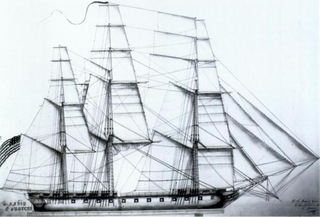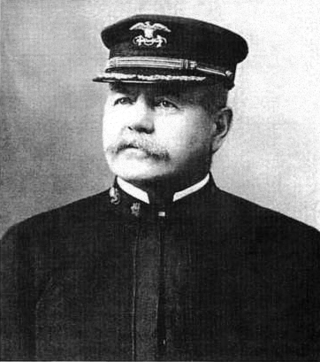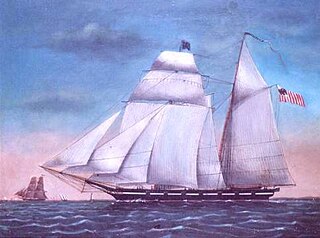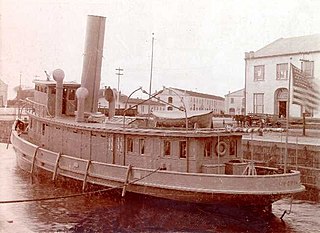
USS Congress was a nominally rated 38-gun wooden-hulled, three-masted heavy frigate of the United States Navy. James Hackett built her in Portsmouth New Hampshire and she was launched on 15 August 1799. She was one of the original six frigates whose construction the Naval Act of 1794 had authorized. The name "Congress" was among ten names submitted to President George Washington by Secretary of War Timothy Pickering in March 1795 for the frigates that were to be constructed.Joshua Humphreys designed these frigates to be the young Navy's capital ships, and so Congress and her sisters were larger and more heavily armed and built than the standard frigates of the period.

Frank Hamilton Newcomb was a United States Revenue Cutter Service commodore, best known for his actions at the Battle of Cárdenas during the Spanish–American War.
United States naval architects or ship designers introduced the faster and larger sailing frigates and sloop-of-wars of the early United States Navy which influenced the later merchant ships and clipper ships.

USCGC Acushnet (WMEC-167) was a cutter of the United States Coast Guard, homeported in Ketchikan, Alaska. She was originally USS Shackle (ARS-9), a Diver-class rescue and salvage ship commissioned by the United States Navy for service in World War II. She was responsible for coming to the aid of stricken vessels and received three battle stars during World War II, before a long career with the Coast Guard. Acushnet patrolled the waters of the North Pacific and was one of the last World War II era ships on active duty in the US fleet upon her retirement in 2011.

The United States Revenue Cutter Taney was one of the 13 cutters of the Morris-Taney class. These cutters were the backbone of the Revenue Cutter Service for more than a decade. Samuel Humphreys designed these cutters for roles as diverse as fighting pirates, privateers, combating smugglers and operating with naval forces. He designed the vessels on a naval schooner concept. They had Baltimore Clipper lines. The vessels built by Webb and Allen, designed by Isaac Webb, resembled Humphreys' but had one less port.

USRC Hudson, known for her service during the Battle of Cárdenas, was the United States Revenue Cutter Service's first vessel to have a steel hull and triple-expansion steam engine.
The United States Revenue Cutter Ingham was one of the 13 Coast Guard cutters of the Morris-Taney class. Named for Secretary of the Treasury Samuel D. Ingham, she was the first United States warship to engage a Mexican ship in combat; and for her service in that battle, a newspaper called her Semper Paratus, which later became the motto of the United States Coast Guard. Ingham was sold in 1836 to the Republic of Texas and served in the Texas Navy until she was captured as a prize-of-war by Mexico and was rechristened Independencia.

The Morris-Taney-class revenue cutters were 13 cutters built at New York City at the Webb and Allen shipyard between 1830–1833. These cutters were the backbone of the United States Revenue-Marine for more than a decade. Samuel Humphreys designed these cutters for roles as diverse as fighting pirates, privateers, combating smugglers and operating with naval forces. He designed the vessels on a naval schooner concept. They had Baltimore Clipper lines. The vessels, built by Webb and Allen, were designed by Isaac Webb and resembled Humphreys' design but had one less port.

The United States Revenue Cutter Crawford was the first of the 13 cutters of the Morris-Taney Class to be launched. These cutters were the backbone of the U.S. Revenue Cutter Service for more than a decade. Samuel Humphreys designed these cutters for roles as diverse as fighting pirates, privateers, combating smugglers and operating with naval forces. He designed the vessels on a naval schooner concept. They had Baltimore Clipper lines. The vessels built by Webb and Allen, designed by Isaac Webb, resembled Humphreys' but had one less port

The United States Revenue Cutter Dexter was one of 13 cutters of the Morris-Taney Class to be launched. Named after Secretaries of the Treasury and Presidents of the United States, these cutters were the backbone of the Service for more than a decade. Samuel Humphreys designed these cutters for roles as diverse as fighting pirates, privateers, combating smugglers and operating with naval forces. He designed the vessels on a naval schooner concept. They had Baltimore Clipper lines. The vessels built by Webb and Allen, designed by Isaac Webb, resembled Humphreys' but had one less port.

The USRC Gallatin was a revenue cutter of the United States Revenue-Marine, one of 13 cutters of the Morris-Taney class to be launched. Named after Secretaries of the Treasury and Presidents of the United States, these cutters were the backbone of the U.S. Revenue-Marine for more than a decade. Samuel Humphreys designed these cutters for roles as diverse as fighting pirates, privateers, combating smugglers, and operating with United States Navy forces. He designed the vessels on a naval schooner concept. They had Baltimore Clipper lines. The vessels built by Webb and Allen, designed by Isaac Webb, resembled those of Humphreys, but had one less port.

The United States Revenue Cutter Hamilton was one of 13 cutters of the Morris-Taney Class to be launched. Named after Secretaries of the Treasury and Presidents of the United States, these cutters were the backbone of the Service for more than a decade. Samuel Humphreys designed these cutters for roles as diverse as fighting pirates, privateers, combating smugglers and operating with naval forces. He designed the vessels on a naval schooner concept. They had Baltimore Clipper lines. The vessels built by Webb and Allen, designed by Isaac Webb, resembled Humphreys' but had one less port.

USRC Rush was one of 13 cutters of the Morris-Taney class to be launched. Named after Secretaries of the Treasury and Presidents of the United States, these cutters were the backbone of the Service for more than a decade. Samuel Humphreys designed these cutters for roles as diverse as fighting pirates, privateers, combating smugglers and operating with naval forces. He designed the vessels on a naval schooner concept. They had Baltimore Clipper lines. The vessels built by Webb and Allen, designed by Isaac Webb, resembled Humphreys' but had one less port.

The United States Revenue Cutter Wolcott was one of 13 revenue cutters of the Morris-Taney Class to be launched. Named after Secretaries of the Treasury and Presidents of the United States, these cutters were the backbone of the United States Revenue-Marine for more than a decade. Samuel Humphreys designed these cutters for roles as diverse as fighting pirates, privateers, combating smugglers and operating with naval forces. He designed the vessels on a naval schooner concept. They had Baltimore Clipper lines. The vessels built by Webb and Allen, designed by Isaac Webb, resembled Humphreys' but had one less port.

The United States Revenue Cutter Jackson was one of 13 cutters of the Morris-Taney Class to be launched. Named after Secretaries of the Treasury and Presidents of the United States, these cutters were the backbone of the Revenue Cutter Service for more than a decade. Samuel Humphreys designed these cutters for roles as diverse as fighting pirates, privateers, combating smugglers and operating with naval forces. He designed the vessels on a naval schooner concept. They had Baltimore Clipper lines. The vessels built by Webb and Allen, designed by Isaac Webb, resembled Humphreys' but had one less port.

The United States Revenue Cutter Jefferson was one of 13 cutters of the Morris-Taney Class to be launched. Named after Secretaries of the Treasury and Presidents of the United States, these cutters were the backbone of the Service for more than a decade. Samuel Humphreys designed these cutters for roles as diverse as fighting pirates, privateers, combating smugglers and operating with naval forces. He designed the vessels on a naval schooner concept. They had Baltimore Clipper lines. The vessels built by Webb and Allen, designed by Isaac Webb, resembled Humphreys' but had one less port.

The United States Revenue Cutter McLane was one of 13 cutters of the Morris-Taney Class to be launched. Named after Secretaries of the Treasury and Presidents of the United States, these cutters were the backbone of the Service for more than a decade. Samuel Humphreys designed these cutters for roles as diverse as fighting pirates, privateers, combating smugglers and operating with naval forces. He designed the vessels on a naval schooner concept. They had Baltimore Clipper lines. The vessels built by Webb and Allen, designed by Isaac Webb, resembled Humphreys' but had one less port.

USCGC Tallapoosa (WPG-52) was a United States Coast Guard cutter of the Tallapoosa-class and was designed to replace the revenue cutter Winona. Her hull was reinforced for light icebreaking. She was initially stationed at Mobile, Alabama, with cruising grounds to Lake Pontchartrain, Louisiana and Fowey Rocks, Florida. During World War I she escorted convoys out of Halifax, Nova Scotia. After the war she served with the Bering Sea Patrol before returning to Savannah, Georgia before World War II. During the war Tallapoosa assisted with convoy escort duty and anti-submarine patrols.

The United States Revenue Cutter Washington, named for Founding Father and the first U.S. president George Washington, was one of the 13 cutters of the Morris-Taney class. These cutters were the backbone of the United States Revenue Cutter Service for more than a decade. Samuel Humphreys designed these cutters for roles as diverse as fighting pirates, privateers, combating smugglers and operating with naval forces. He designed the vessels on a naval schooner concept. They had Baltimore Clipper lines. The vessels built by Webb and Allen, designed by Isaac Webb, resembled Humphreys' but had one less port.
USRC Detector was a Wasp-class schooner built for and operated by the United States Revenue Cutter Service from 1825 to 1832. She is the second ship of the Revenue Cutter Service to bear the name.






